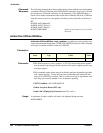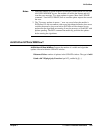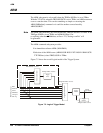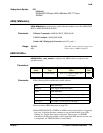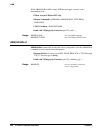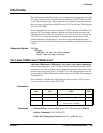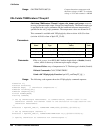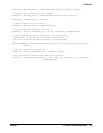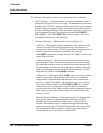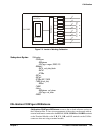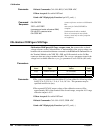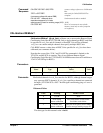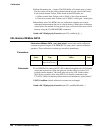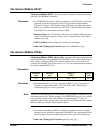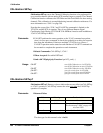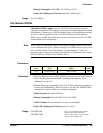
262 VT1422A Command Reference Chapter 7
CALibration
CALibration
The Calibration subsystem provides for two major categories of calibration.
1. "A/D Calibration"— In these procedures, an external multimeter is used to
calibrate the A/D gain on all five of its ranges. The multimeter also determines
the value of the VT1422A's internal calibration resistor. The values generated
from this calibration are then stored in nonvolatile memory and become the
basis for "Working Calibrations. These procedures each require a sequence of
several commands from the CALibration subsystem (CAL:CONFIG…,
CAL:VALUE… and CAL:STORE ADC). Always execute *CAL? or a
CAL:TARE operation after A/D Calibration.
2. "Working Calibration"—Which has three levels (see Figure 7-3):
-- "A/D Zero"—This function quickly compensates for any short term A/D
converter offset drift. This would be called the auto-zero function in a
conventional voltmeter. In the VT1422A where channel scanning speed is of
primary importance, this function is performed only when the
CAL:ZERO? command is executed. Execute CAL:ZERO? as often as the
control setup will allow.
-- "Channel Calibration"—This function corrects for offset and gain errors
for each module channel. The internal current sources are also calibrated.
This calibration function corrects for thermal offsets and component drift
for each channel out to the input side of the Signal Conditioning Plug-On
(SCP). All calibration sources are on-board and this function is invoked
using either the *CAL? or CAL:SETup command.
-- "Channel tare"—This function (CAL:TARE) corrects for voltage offsets in
external system wiring. Here, the user places a short across transducer
wiring and the voltage that the module measures is now considered the
new "zero" value for that channel. The new offset value can be stored in
non-volatile calibration memory (CAL:STORE TARE) but is in effect
whether stored or not. System offset constants which are considered
long-term should be stored. Offset constants which are measured relatively
often would not require non-volatile storage. CAL:TARE automatically
executes a *CAL?
-- "Remote Channel Calibration"—This function corrects for gain and offset
errors in each channel of a Remote Signal Conditioning unit (RSC).
Each RSC has its own calibration voltage source as well as shorting
switches. The calibration source is measured through dedicated analog
connections between the VT1539A SCP and the RSC. The source is then
used to stimulate the RSCs amplifiers to calibrate gain. The shorting
switches provide a zero volt source to calibrate offset.



